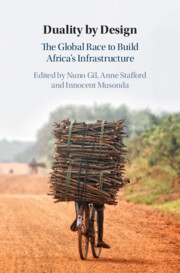Book contents
- Reviews
- Duality by Design
- Duality by Design
- Copyright page
- Contents
- Figures
- Tables
- Contributors
- Foreword
- Acknowledgements
- 1 Duality by Design: The Global Race to Build Africa’s Infrastructure
- Part I Mitigating Institutional Voids by Design
- Part II Exploiting Institutional Voids by Design
- Afterword
- Index
- References
1 - Duality by Design: The Global Race to Build Africa’s Infrastructure
Published online by Cambridge University Press: 14 November 2019
- Reviews
- Duality by Design
- Duality by Design
- Copyright page
- Contents
- Figures
- Tables
- Contributors
- Foreword
- Acknowledgements
- 1 Duality by Design: The Global Race to Build Africa’s Infrastructure
- Part I Mitigating Institutional Voids by Design
- Part II Exploiting Institutional Voids by Design
- Afterword
- Index
- References
Summary
This book starts from the idea that much can be learned about the design of new forms of organising, theoretically and empirically, by examining a phenomenon central to the global order: Africa’s struggle to bridge a growing gap between supply and demand for basic infrastructure. A gap linked, amongst other factors, to the rapid growth of the continent’s population, projected to reach 40 per cent of the world’s population by 2100.1 Infrastructure is a vast class of capital-intensive technologies that input into a wide range of productive processes that generate positive externalities and social surplus.
Information
- Type
- Chapter
- Information
- Duality by DesignThe Global Race to Build Africa's Infrastructure, pp. 1 - 30Publisher: Cambridge University PressPrint publication year: 2019
References
Accessibility standard: Unknown
Why this information is here
This section outlines the accessibility features of this content - including support for screen readers, full keyboard navigation and high-contrast display options. This may not be relevant for you.Accessibility Information
- 2
- Cited by
